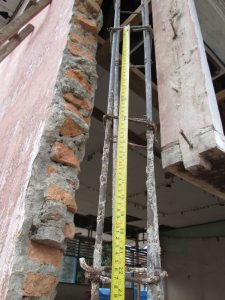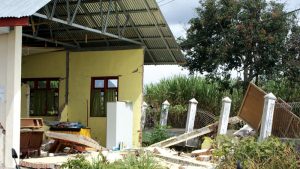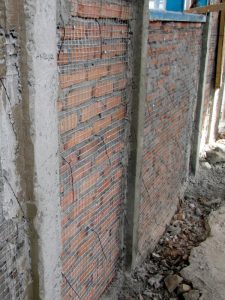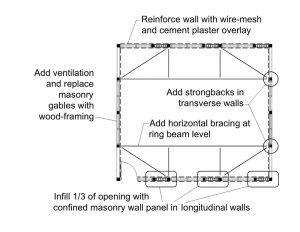An International Collaboration
Post-earthquake observations following recent events in Indonesia point to the significant vulnerability of school infrastructure in the country. Build Change is a Denver-based international non-profit social enterprise that works with people in emerging nations to design, build, finance, and regulate disaster-resistant houses and schools. Build Change has a program in Padang, Indonesia, and has responded to eight large earthquakes there since the program’s inception after the 2004 Indian Ocean earthquake and tsunami. By learning first, through activities like post-earthquake reconnaissance and sub-sector studies, Build Change aims to provide technical assistance to post-earthquake reconstruction – from support in design and building standards through training in construction and material quality. Evidence of damaged and vulnerable school construction was apparent after every visit to the earthquake-affected areas in Indonesia following the Yogyakarta (2006), the Bengkulu (2007), the Padang (2009), the Central Aceh (2013), the Pidie Jaya (2016), the Lombok (2018) and the Palu (2018) earthquakes. More than 1,000 schools were reported to be damaged or destroyed in each of the 2006/2009 and both 2018 events alone.
A Reoccurring Problem
Many school buildings in Indonesia are constructed as one-story, partially-confined masonry structures with light-framed roofs. In Padang, the capital city of West Sumatra, this building type makes up approximately 60% of the public school buildings. Confined masonry is a commonly used structural system outside of the U.S. in which unreinforced or lightly reinforced masonry load-bearing walls are constructed and surrounded on the sides, top, and bottom by reinforced concrete elements, or “ties.” These ties help to “confine” the masonry wall. Building codes in seismic regions, such as Chile and Mexico, cover the requirements for this building type to resist earthquakes and, when built properly, low-rise confined masonry structures have resisted earthquakes well. Interestingly, Indonesia’s building code does not cover confined masonry, even though the Ministry of Education’s school construction guidelines promote its use.
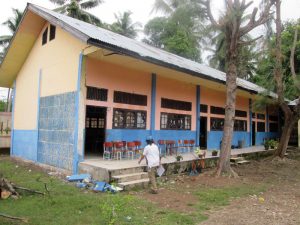
Typical classroom building – Note the lack of confining elements at door and window jambs, lack of ring beam at the side wall, and very minimal length of wall pier in the longitudinal direction.
Unfortunately, for the observed school buildings of this type in Indonesia, some of the reinforced concrete elements are missing and they are better described as partially confined than fully confined. Confining elements are typically placed at wall intersections but are rarely installed at door and window jambs as would be required for good performance. Wall piers between openings are effectively unconfined in these cases and have essentially no more ductility than an unreinforced masonry wall. Often, lintel beams are not installed over window and door openings, leaving the masonry panel above to rest on the wood framing of the opening. In some cases, the required ring beam, or confining beam at the top of the wall, is also missing, leaving the masonry wall panel unbraced at the top and very susceptible to toppling under out-of-plane loading.
In addition to missing key confining elements, problems with configuration and construction quality are frequently observed in these school buildings. The longitudinal walls along the front and back consist mostly of openings for doors and windows, leaving very few short wall piers to resist earthquake loads. The buildings also typically lack an effective diaphragm, as the light-framed roof is not detailed to act as a diaphragm and not well-connected to the building walls. This is especially problematic in cases where the building has a masonry gable end wall, which remains poorly braced over a much taller height than the rest of the building.
Most of the classroom buildings of this type are built by local builders who may have more experience in construction of smaller non-engineered buildings, like houses, and construction activities are not typically observed by the designer or inspected by local authorities in detail. It is common for smooth reinforcing bars to be used in the concrete elements, for the brick strength to be low, for the concrete quality to be poor, and for construction details like adequate concrete cover, reinforcing hooks and splices, or mortar quality and placement to be overlooked.
Considering the incomplete confinement and the problems with configuration and construction quality, the performance of these buildings has been poor in recent earthquakes, characterized by significant damage, partial collapse, and total collapse in some cases.
The problem is not localized; many more vulnerable buildings of this type exist in earthquake-prone areas across Indonesia. Indonesia is the fourth most populated country in the world, following the United States, and with over 50 million students attending more than 300,000 schools, it also has the fourth largest education system in the world. Seventy-five percent of Indonesia’s schools are in disaster risk areas; the nearly 800,000-square mile country is exposed to large earthquakes, tsunamis, high winds, volcanoes, landslides, and floods. From these numbers, it is estimated that there could be between 250,000 to 400,000 buildings of this type within the country at risk from earthquakes.
Finding a Solution
New school buildings are continuously added to the educational infrastructure in Indonesia in an attempt to keep up with demand. However, it is not economically feasible to demolish and replace all existing vulnerable buildings as a universal solution. Many of the existing buildings will remain indefinitely, so cost-effective options for improving them are needed. At the same time, improvements in new building construction methods are urgently needed. This is something the authors are also working with the Ministry of Education to achieve.
To explore solutions for existing classrooms, Build Change worked with the local Education Department in Padang to select a representative school, of the one-story confined masonry type, as an example for developing cost-effective retrofit options using locally-available materials and labor. The authors and their Indonesian colleagues gathered information relevant to the retrofit design to consider various techniques. Information was derived from the Indonesian building code, from existing national and international guidelines, from research performed by others and by Build Change, and from the authors’ own experiences. Due to the common use of low-strength, single-wythe brick in Indonesia, several researchers in Indonesia and Japan had already developed and tested retrofit techniques to strengthen the slender masonry for in-plane and out-of-plane loading successfully. Solutions included using a cement-plaster overlay or banded steel wire mesh combined with a cement-plaster overlay.
The authors selected a shear wall system for the retrofit, although several other schemes were considered including a moment frame system and a cantilevered column system. The resulting retrofit scheme targeted life-safety performance for the code-prescribed design earthquake and was composed of several key components:
- Infilling select wall openings in the longitudinal walls to create sufficient length of the wall and installing confining elements at their boundaries.
- Overlaying walls with steel wire mesh and cement-plaster and, in some cases, rebuilding the wall pier to be thicker masonry to improve in-plane and out-of-plane strength.
- Adding reinforced concrete strongbacks to the transverse walls for out-of-plane bracing.
- Installing a new continuous ring beam at the top of the wall.
- Installing a horizontal bracing system just above ceiling level connected to the ring beam to act as a diaphragm.
- Eliminating any unreinforced masonry above window and door openings by extending the opening upwards to the ring beam and filling the space with light-weight materials instead.
- Eliminating the masonry gables and replacing them with light-weight materials.
In addition to these structural improvements, new braced ceilings were proposed for the classroom interiors, and additional natural light and ventilation were proposed for the transverse end walls.
Piloting the Retrofit
Two single-classroom buildings in the example school were selected for piloting the retrofit construction project. One of these had been lightly damaged by the 2009 earthquake and was no longer in use. Construction quality supervision was provided throughout the duration of the work to ensure that the contractor followed the construction documents. Additionally, experienced builder trainers frequently visited the site to provide pointers and support to the workers to achieve a good quality construction. Bricks were purchased from suppliers that offered tested and certified-strength bricks.
The construction started in January 2016 on one of the two buildings and the second building was completed in May 2016. Most of the retrofit techniques were familiar to the local builders, except installing the mesh-plaster overlay; however, the required level of construction quality was higher than the builders were accustomed to and this led to some delays. For new techniques, like the wire mesh overlay, extra care was taken in the detailing and on-site supervision of the mesh installation, which the builders were able to master after an initial period of familiarization.
In addition to the construction work, engagement of the school community was a component of the pilot project. Early retrofit planning was accompanied by significant efforts to involve and increase the disaster-risk awareness of the school community. Training materials on the retrofit were developed, and a retrofit awareness workshop was held for representatives of the school council, the Education Department, and the Regional Disaster Management Agency. During construction, Build Change Indonesian staff and members from the school council jointly performed the construction supervision, with discussions on good construction practice and review of construction quality checklist items. The pilot retrofit was also used as an opportunity to raise the topic of disaster-risk and prevention with students and teachers. Presentations on how earthquakes affect buildings were given to the students and the materials were shared with teachers for future use.
The construction of the retrofit improved these two buildings and also permitted the validation of construction cost estimates and constructability of retrofitting details. The total cost of the project, including the construction costs, the design, the construction quality supervision and support, and the school community outreach was approximately $32,000 total for both buildings or approximately $27 per square foot.
Plans for Scale
After the completion of the pilot project, the authors and their Indonesian colleagues have completed the design and construction of a retrofit for the other, larger classroom building at the same school. The larger building has four classrooms and an administrative office. The overall retrofit scheme is the same, with small adaptations. By repeating the retrofit design process and incorporating lessons from the pilot retrofit, the team refined the retrofit design and detailing. The next step is to develop simple guidelines that could be used at a larger scale for the application and adaptation of the retrofit scheme to many more buildings of the same type. This would allow a more prescriptive approach to retrofitting many of the vulnerable classroom buildings in Indonesia, as long as the characteristics of the buildings align with those of the applicable type. In addition to coordinating with the National Ministry of Education and local Education Department in Padang, Build Change is currently seeking partners to support this scale-up of school retrofitting.▪
Build Change has 100 technical staff in six programs globally. For more information on Build Change and a downloadable copy of their post-earthquake reconnaissance reports, please visit www.buildchange.org. The authors would like to thank those that made the work described possible: The Education Department of Padang for their partnership, and Simpson Strong-Tie, the Thornton Tomasetti Foundation, and the New Zealand Embassy in Indonesia for their support.

